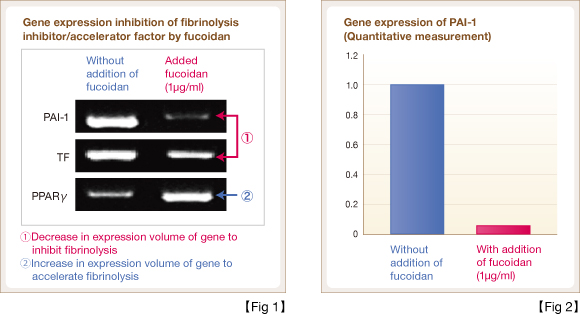The Research group of Tottori University, Faculty of Medicine, announced their research achievement on the "Inhibition of lipid droplet accumulation of fat cells by fucoidan" at the 31st "Congress of the Japanese Society on Thrombosis and Hemostasis" held on November 20, 2008, at the Osaka International House Foundation. 1)
The following is a summary of their research.
Also increasing the survival rate-extensive possibilities
Blood is a biological fluid that serves absolutely imperative functions to maintain human and animal life.
Blood carries oxygen to all body tissues and sends carbon dioxide to the lung to be discharged.
While blood delivers nutrients such as sugars, fats, vitamins, and minerals to all parts of the body, it also delivers waste to the kidneys to be discharged from the body.
Further it has immune functions which detect viruses, fungi, bacteria, and cancer cells, breaks them down and eliminates them.
The body of an animal has the function to suppress outgoing blood flow by clotting the blood and repairing when a blood vessel is injured.
A blood clot is formed to block the injured site. The blood clot is degraded and absorbed in blood as the injured spot is repaired.
The blood clot absorbing activity is called fibrinolysis.
When fibrinolytic activity becomes abnormal, thrombosis occurs.
Thrombosis causes Ischemia [1] and Infarct [2] by blocking blood vessels with blood clots.
One of the causes that induce thrombosis is obesity. Endothelium of the blood vessel gets easily injured, and blood is easily clotted.
Hypertrophic fat cells [3] activate the expression of plasminogen activator inhibitor (PAI-1) [4] and tissue factor (TF) [5], inhibiting blood clots from becoming reabsorbed into blood (fibrinolytic activity).
Confirmed the effects leading to the prevention of thrombosis by using cultured cells
We examined whether or not fucoidan influences the expression of hypertrophic fat cells PAI-1 and TF, using cultured cells.
It was confirmed that expression levels of PAI-1 was significantly suppressed when we cultivated fat cells in the presence of fucoidan (1μg/ml) in a culture media with a high concentration of glucose.
Also it was confirmed that expression levels of TF was suppressed.
These results indicate that fucoidan suppresses the expression of thrombosis factors and possesses the possibility of preventing thrombosis.
In addition, when we cultivated fat cells in the presence of a high concentration of fucoidan (100μg/ml), accumulation of lipid droplets [6] of fat cells was remarkably inhibited. (Fig 2)
From these results we may assume that fucoidan inhibits fat cells to enlarge and endothelium of blood vessels to get easily injured.

[Sources] 1)"Inhibition of lipid droplets accumulation of fat cells by fucoidan and inhibition of gene expression of clotting factor by fucoidan". Written by Mr. Teru Hayashi on The booklet of the 31st "Congress of the Japanese Society on Thrombosis and Hemostasis" 19(5), 689 (2008).
- Glossary
-
[1]Ischemia/Due to decrease of blood volume in artery, a part of the body has anemia. While ischemia continues as it is, cell form changes or cell dies.
[2]Infarct/After ischemia occurs, blood hardly flows, oxygen and nutrition are not delivered well, and cells are killed from absence of oxygen.
[3]Fat cell/A cell which has much fat in cell cytoplasm and constitutes fat tissues. At the time of energy shortage such as on an empty stomach and during exercises, it takes roll to break down fat and creates much energy.
In addition, the fat tissue secretes various physiologically active substances.
It is known to secrete substances related to clot blood.[4]Plasminogen activator inhibitor (PAI-1)/Plasminogen is the name of the inactive form of plasmin which is a protein that breaks down clotted blood.
Plasminogen is changed to its active form plasmin by the "plasminogen activating factor". Plasminogen activator inhibitor (PAI-1) is a type of protein unitizing plasminogen activating factor to inhibit its activity.
As a result, plasminogen (the inactive form) cannot become plasmin (the active form) and fibrinolysis activity (action to reabsorb clotted blood into blood) is inhibited.[5]Tissue factor (TF)/A protein which is responsible for initiating blood clotting. It is abundantly distributed at organs where a minor bleeding could be fatal (brain, lung, and placenta).
[6]Lipid droplets/Droplets of fat existing in cell cytoplasm. Neutral fats are stored. In an overweight status, excessive neutral fats are stored as lipid droplets.







